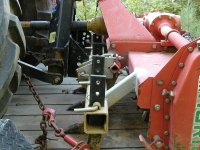Bill, I'm sure there are some people who have no need or use for a tiller, mostly because they'll say they don't raise a garden. And that's fine, but for me the tiller is one of the most useful tools. I do raise a garden, so a tiller of some kind is the best gardening tool I know of. However, there are lots of other uses. Blades and box blades are great for smoothing and leveling, but what if you have big hard clods like we get when something is dug up when it's wet and then dries? On more than one occasion, after a septic system was installed, the ground settled, had to haul in more dirt, sometimes big hard clods. The tiller busted them up so they could be spread and smoothed, whether with the front end loader, a blade, or a rake. There are times when I want to move dirt, and I can tear it up with the scarifiers on the box blade, then scoop it up in the front end loader, but if I want it to be easy to spread and smooth, I run the tiller over it before scooping it up to move to where I want it. Sometimes if you want to level something and the ground is hard, you can just use a box blade, but of course, the dirt you scrape off the high spots is soft and loosened up, you move it into the low spots and it looks great, but after the first rain, the dirt that was moved settles, while the high spots you scraped it from were already hard and settled and don't move. If you till the whole thing first, high and low spots, then smooth it out, it's all more likely to settle together. Anyway, I think you're wise to be looking for a tiller for your tractor. Get one that's just as wide as your rear tires, or wider, and you'll find lots of uses for it.

